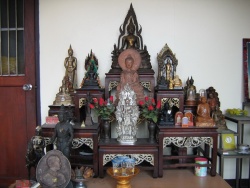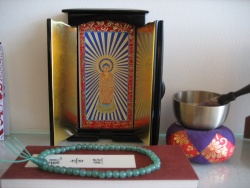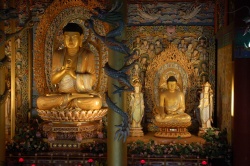How to Create a Buddhist Altar
The Buddhist Altar is called a Butsudan. The picture I have on the top of this blog is a view of a traditional altar. Altars can be of whatever kind that you like. Please take the following as a guide but I believe an altar is more special when it is made with things that have specific spiritual meaning to you. You may place photos of family members. Many do this who are of the Amidism tradition as a form of
ancestral worship/honor. Some place photos of their Guru. Altars can also be placed outside, this is very common in Japan and some parts of the Himalayas. Many believe making objects like statues carved from wood or clay bring good fortunes in the next life. So do what makes you feel comfortable in making that special place for you to sit and meditate and worship. Below are some concepts that may prove helpful and I hope interesting study. Happy Altar making!
~Buddhist Altar
Having an altar in your place of meditation can be of help. Lighting the altar candle and offering incense can have the effect of quieting in the midst of a busy day and allow for focusing the mind before meditating.
The Buddha on the altar is a reminder of the stillness and compassion found within meditation. Making the altar beautiful and joyful with flowers and incense encourages looking up within the concerns of everyday life.
Let the altar be as elaborate or as simple as is appropriate to your circumstances.
The elements of an altar are: a statue, picture or scroll of a Buddha or Bodhisattva; flowers or a plant; a candle; a water offering cup; and an incense bowl.
The flowers are usually arranged to show aspects of the Teaching:
A single flower to show the unity of all beings;
Three flowers to represent the Three Treasures;
Four to represent the Four Noble Truths; and so on.
Flowers represent the offering of our training and may reflect the season as a reminder of impermanence.
The candle is placed on the Buddha's left side (the right-hand side facing the altar). This represents the light of the Buddha's Teaching which comes from the Compassionate Heart of Buddha. For safety on a small altar, a night light or candle in a votive glass works very well.
The water offering cup placed in front of the Buddha symbolizes the cleansing power of meditation that converts greed, anger and delusion into compassion, love and wisdom. The cup is always kept full, symbolizing that the water of the spirit is always there.
The incense bowl stands in front of the water cup. This bowl should be filled with ash or sand and should be deep enough that lit sticks of incense inserted into it can stand upright. Incense is lit and offered before a meditation period or when you feel it might be useful to have a short period of recollection to ground yourself during a busy day.
The incense stick can also be used to time a meditation period. A five to six inch stick takes about 30 minutes to burn down.
The perfume of the incense permeates all corners of the room and thus symbolizes the power of the Teaching to reach and convert all forms of greed, hate and delusion.


